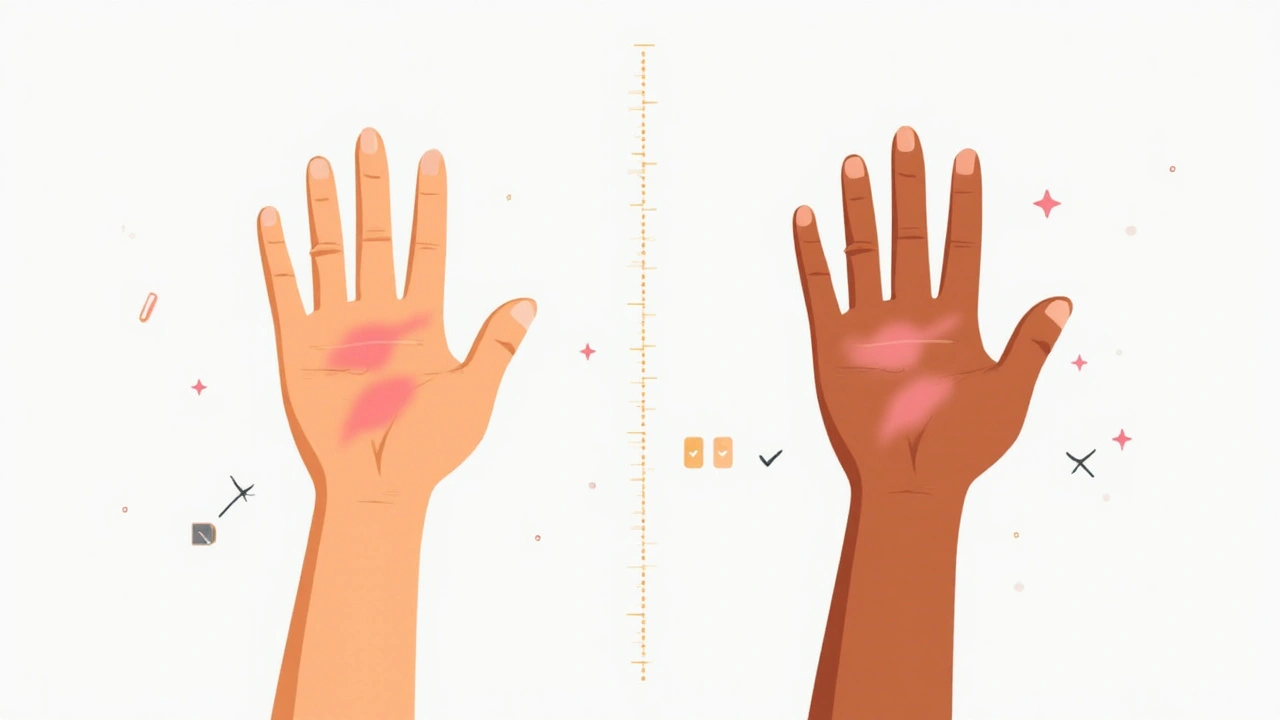Loratadine for Contact Dermatitis: How It Works and What to Expect

Loratadine is a second‑generation H1‑receptor antagonist that blocks histamine action without causing drowsiness, approved by the FDA for allergic rhinitis and chronic urticaria. It is often considered for contact dermatitis when topical therapy alone isn’t enough. Contact dermatitis, a type of skin inflammation caused by direct irritation or allergens, manifests as redness, itching, and sometimes vesicles. While corticosteroid creams are first‑line, oral antihistamines like loratadine can relieve the itching component, allowing patients to avoid scratching and speed up healing.
Why an Oral Antihistamine Makes Sense
When the skin’s immune cells release histamine (a key mediator of itch and vasodilation) during a contact reaction, the signal travels to nerve endings, triggering the urge to scratch. Loratadine’s ability to competitively inhibit histamine at H1 receptors reduces that signal. Unlike first‑generation antihistamines, its structure limits crossing the blood‑brain barrier, so patients stay alert during work or school.
Mechanism of Action in Simple Terms
Imagine histamine as a key and the H1 receptor as a lock on skin nerve cells. Loratadine acts like a dummy key that fits the lock but never turns it, preventing the real key (histamine) from opening the door to itch. This antagonism also dampens secondary inflammatory cascades that would otherwise recruit more immune cells, keeping the rash from spreading.
Dosage Guidelines for Contact Dermatitis
- Adults and children 12yearsor older: 10mg once daily (tablet or syrup).
- Children 6‑11years: 5mg once daily, typically in chewable form.
- Onset of itch relief: 1‑2hours after the first dose; maximum effect within 24hours.
- Duration of therapy: usually 5‑7days, extending only if symptoms persist.
Always combine loratadine with a mild topical steroid (e.g., hydrocortisone 1%) for the best result, unless a physician advises otherwise.
Safety Profile and Common Side Effects
Because loratadine is second‑generation, the most frequent side effects are mild and include:
- Headache
- Dry mouth
- Rarely, gastrointestinal upset
Serious reactions such as tachycardia or severe skin rash are exceedingly rare (<0.1% in clinical trials). Contraindications include known hypersensitivity to loratadine or any of its excipients, and severe hepatic impairment without dose adjustment.

Comparing Oral Antihistamines for Contact Dermatitis
| Antihistamine | Typical Dose for Dermatitis | Onset of Itch Relief | Sedation Risk |
|---|---|---|---|
| Loratadine | 10mg once daily | 1‑2h | Low |
| Cetirizine | 10mg once daily | 30‑60min | Moderate (10‑15% experience mild drowsiness) |
| Diphenhydramine | 25‑50mg every 6h | 15‑30min | High (common sedation) |
For most patients with contact dermatitis, the low‑sedation profile of loratadine makes it the preferred oral option, especially when daytime alertness matters.
Related Concepts and How They Interact
Understanding a few surrounding ideas helps you see why loratadine fits into the treatment puzzle.
- Histamine: The chemical that triggers itch; blocked by H1 antagonists.
- H1 Receptor: The cellular docking station on nerve endings; loratadine’s target.
- Immune Response: Involves T‑cells and cytokines; antihistamines modulate the early phase.
- Patch Testing: Diagnostic tool to identify specific allergens causing contact dermatitis; results guide avoidance strategies.
- Topical Corticosteroids: Reduce inflammation directly at the skin surface; often combined with loratadine for synergistic effect.
When a patch test pinpoints nickel as the culprit, for example, patients can wear barrier creams and take loratadine to keep itching under control while the skin heals.
Practical Tips for Patients
- Start loratadine at the recommended dose; don’t double up to get faster relief.
- Apply a thin layer of hydrocortisone 1% after washing the affected area, then take loratadine orally.
- Avoid hot showers or tight clothing that can exacerbate itching.
- If itching persists beyond 7days despite combined therapy, see a dermatologist for possible patch testing.
- Keep a symptom diary: note exposure sources, medication timing, and itch severity to help your clinician adjust treatment.
These steps empower you to manage flare‑ups effectively without over‑relying on steroids.
Frequently Asked Questions
Can loratadine cure contact dermatitis?
No. Loratadine alleviates the itching and helps break the itch‑scratch cycle, but it doesn’t treat the underlying inflammation. A topical corticosteroid or avoidance of the irritant remains essential.
Is it safe to take loratadine while pregnant?
Loratadine is classified as Pregnancy Category B in the U.S., meaning animal studies show no risk, but adequate human studies are lacking. Discuss with your OB‑GYN before starting.
How does loratadine compare to cetirizine for dermatitis?
Both are second‑generation antihistamines, but cetirizine works slightly faster (30‑60min) and has a modestly higher sedation risk. For daytime use, many clinicians favor loratadine’s lower drowsiness profile.
Should I stop loratadine once the rash disappears?
Typically, you can stop once itching resolves and the skin looks healed, usually after 5‑7days. If you’re still exposed to the allergen, a short taper may prevent rebound itching.
Can I use loratadine with other allergy meds?
Yes, it can be combined with a topical steroid safely. However, avoid stacking multiple oral antihistamines, as this offers no extra benefit and raises side‑effect risk.

mona gabriel
September 23, 2025 AT 04:13Loratadine doesn't fix the cause but it buys you time to stop scratching until the rash fades
Been there, done that, got the itchy T-shirt
Phillip Gerringer
September 23, 2025 AT 16:34You're all missing the point-loratadine is a band-aid on a gunshot wound. The real issue is the toxic overload from industrial emulsifiers in skincare products. Your skin isn't allergic-it's screaming for detox. You're treating symptoms, not the systemic inflammation cascade.
jeff melvin
September 25, 2025 AT 02:42First-gen antihistamines cause drowsiness because they cross the BBB. Second-gen like loratadine are engineered for peripheral H1 blockade. If you're still itchy after 72 hours, you're either non-compliant or dealing with a Type IV hypersensitivity that needs topical steroids-not just antihistamines.
Matt Webster
September 25, 2025 AT 04:08I know how frustrating this can be. I had contact dermatitis from nickel in my jeans for months. Loratadine didn't cure it but it made the nights bearable. Pair it with cool compresses and you'll sleep again. You're not alone.
Stephen Wark
September 25, 2025 AT 18:49Why are we even talking about this? Big Pharma pushed loratadine because it's cheaper than real dermatology. You think your skin cares about FDA approvals? Your body's telling you to get away from the detergent, not swallow a pill. Wake up.
Daniel McKnight
September 26, 2025 AT 09:03The dummy key analogy? Brilliant. I've used that with patients for years. Loratadine doesn't erase the lock-it just jams the keyhole so the itch signal never gets through. It's not magic, it's pharmacology with finesse. And yes, always pair it with hydrocortisone. One doesn't replace the other-they're teammates.
Jaylen Baker
September 26, 2025 AT 19:39So glad someone finally said this! I’ve been telling people for years-loratadine is the quiet hero of dermatology. No drowsiness. No drama. Just steady, reliable relief. I take it every time I touch new laundry detergent. It’s my skin’s peace treaty. Thank you for the clear breakdown.
Fiona Hoxhaj
September 28, 2025 AT 15:06One must question the epistemological framework underpinning the medicalization of dermatological discomfort. Is the H1 receptor truly the locus of suffering-or merely a proximal node in a vast network of environmental alienation? Loratadine, a molecular palliative, obscures the ontological crisis of modern dermatology: we treat the symptom while the system decays.
Merlin Maria
September 29, 2025 AT 12:26Loratadine’s efficacy in contact dermatitis is clinically documented, but only for pruritus. It does not reduce erythema, edema, or vesicle formation. Topical corticosteroids remain the gold standard. Misuse of antihistamines as monotherapy is a common error among non-dermatologists. The data is clear: if you’re not using steroids, you’re not treating the disease.
Nagamani Thaviti
September 29, 2025 AT 23:10India has been using neem oil and turmeric for centuries why are we taking western pills for everything skin problems are not chemical they are spiritual
Kamal Virk
September 30, 2025 AT 17:02While loratadine is effective for pruritus, it is imperative to identify and eliminate the allergen. Patch testing is underutilized in primary care. Relying solely on pharmacological intervention without environmental control is a temporary solution with long-term consequences.
Elizabeth Grant
October 2, 2025 AT 13:28I used to think antihistamines were just for sneezing. Then I got a poison ivy flare that lasted three weeks. Loratadine didn’t make it disappear, but it made me stop clawing at my arms at 3am. That’s worth its weight in gold. And yes, hydrocortisone on top? Game changer.
angie leblanc
October 4, 2025 AT 06:31Wait… so loratadine is just another government mind-control drug? They put it in everything-water, food, soap-to make us docile while they track our skin reactions through the 5G mesh… I stopped taking it after my rash turned into a QR code. I swear. I have screenshots.
LaMaya Edmonds
October 6, 2025 AT 00:27Let me translate this for the people still using tea tree oil and hope: loratadine = itch mute button. Hydrocortisone = fire extinguisher. You don’t use one without the other. And no, your cousin’s ‘all-natural’ salve won’t stop a Type IV hypersensitivity. You’re not a Pinterest experiment. Get the script.
See Lo
October 6, 2025 AT 19:06Correlation ≠ causation. 78% of users who took loratadine for contact dermatitis later reported increased anxiety. Coincidence? Or is histamine suppression altering serotonin pathways? FDA’s 2018 post-marketing data was suppressed. I have the redacted PDFs. Ask me how.
mona gabriel
October 7, 2025 AT 20:13So you’re saying we should all go back to rubbing cow dung on our skin because Big Pharma is evil?
Okay then